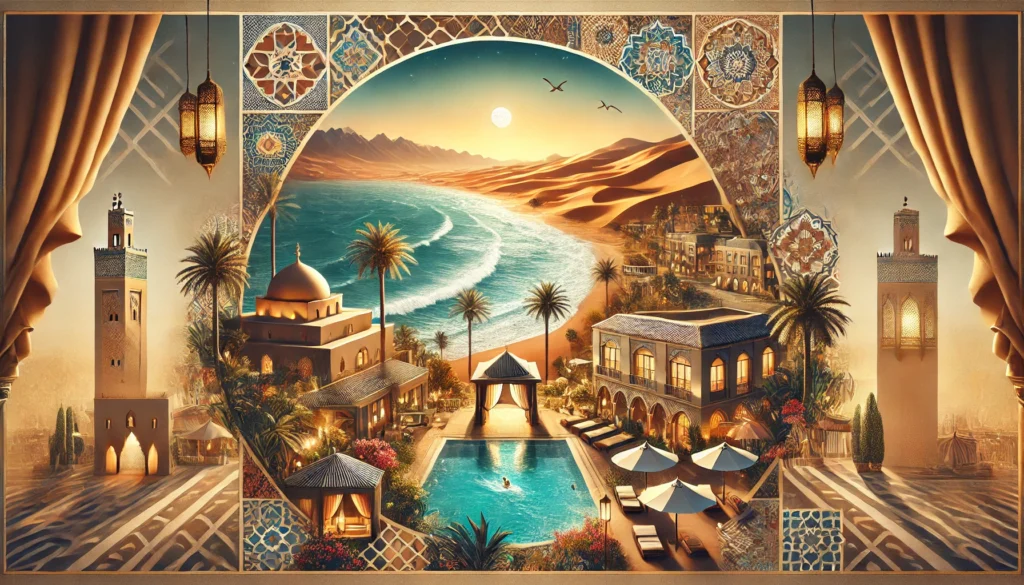Introduction
Moroccan traditional crafts show that the craft culture are part of the social cultural practice that is alive up to this time. They are not only the symbol of indigenous artistry, but also the pillar of the nation’s economical environment and tourism industry. From intricate carpets to fragile ceramics, Morocco’s hand made creations mesmerize international tourists who come for a rich history, tradition and art.
The Background of Moroccan Traditional Crafts
The origins of Moroccan traditional crafts trace back over 3,000 years, showcasing the impacts of Berber, Arab, Andalusian, and African cultures. Each region in Morocco focuses on distinct crafts:
– Fes is understood for its excellent porcelains and zellige (mosaic ceramic tiles).
– Marrakech flaunts natural leather goods crafted in standard tanneries.
– Asilah and Essaouira are celebrated for woodwork and precious jewelry.
Moroccan artisans have actually passed their abilities down through generations, protecting the credibility of their crafts while adjusting to changing preferences.
Economic Influence of Moroccan Traditional Crafts
Moroccan art is the pride of culture and the means of the country’s economy. According to the Ministry of Tourist and Handicrafts:
– From independence, this market represents 7% Of the Moroccan GDP.
– It gives work to 2.4 million artisans, 80% women primarily in the backwoods.
– Exports of traditional crafts account for 30% of the country’s artisanal exports, reaching markets in Europe and North America.
Moroccan Traditional Crafts and Tourist
Tourism and traditional crafts coexist in Morocco. More than 13 million tourists visit Morocco every year, and around 60% of them acquire handcrafted souvenirs.
Top Destinations for Craft Enthusiasts
1. Marrakech’s Jemaa el-Fna Market: Known for its vibrant atmosphere and diverse crafts, this market invites over 2 million site visitors annually.
2. Noteworthy, the souks of Fes Medina, which is packed with the ceramic pots, brass lamps and leather bags.
3. Asilah’s Wood Workshops: Emphasizing on the techniques used in carving pieces by Moroccan craftsmen.
Interactive Experiences: Live Crafting Workshops
The most engaging possibility for a tourist to relate to the heritage of Moroccan craftsmanship is to attend live demonstrations. Such opportunities make it possible for the site visitors to watch the artists at work and perhaps even practice making something themselves, while at the office.. These immersive experiences allow site visitors to observe artisans at the office and even try their hand at crafting.
– Carpet Weaving in Taroudant: Over 15,000 visitors each year join weaving workshops to produce genuine Moroccan carpets.
Pottery Classes in Safi: The pottery capital of Morocco markets over 100,000 items every year, and many vacationers join local potters for hands-on experiences.
Events and Events Celebrating Moroccan Traditional Crafts
To display its abundant artisanal heritage, Morocco hosts several events that bring global attention:
– The International Handicrafts Fair in Rabat: With 500 exhibitors and more than 50,000 attendees annually.
– The Azrou Carpet Festival: A celebration of Berber artisan principles in which the party encourages the sales and manufacture of country-made rugs.
This paper focuses on sustainability in Moroccan Traditional Crafts.
To protect this social heritage for future generations, Morocco has carried out several efforts:
1. Craftsmen Training Programs: With over 70 vocational facilities, young artisans receive education in traditional strategies.
2. Export Promotion: Around 20% of Moroccan traditional crafts are exported to worldwide markets, especially to France and the USA.
3. Digital Operating Systems: Online marketplaces like Artisana increased sales by 35% in 2023, bringing international focus to Moroccan items.
Empowering Ladies Through Moroccan Traditional Crafts
Women central to Moroccan traditional crafts where they constitute about 80% of workforce in craft works such as carpet making and stitching. Programmes organised by cooperatives and local NGOs provide the country ladies with necessary training and financial assistance to enable them earn their keep financially and also retain their cultural values.
These Moroccan crafts are more than simply ‘souvenirs’ they are a reflection of Morocco’s history and creative spirit. These precious crafts are helping Morocco’s economy to become better and attracting thousands of tourists willing to absorb the country’s energy. These production become a more permanent and tangible reminder of a trip through a country of extraordinary imagination for the vacationers.
External Links for Further Reading**
- Ministry of Tourism and Handicrafts
- Moroccan Handicrafts Portal
- UNESCO on Moroccan Intangible Cultural Heritage



